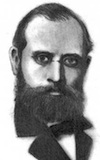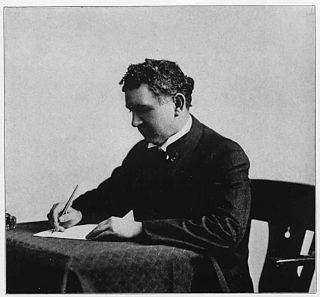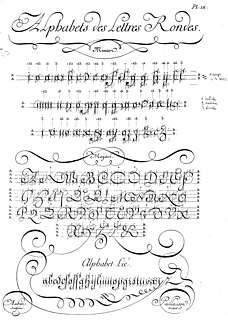
Calligraphy is a visual art related to writing. It is the design and execution of lettering with a broad-tipped instrument, brush, or other writing instrument. A contemporary calligraphic practice can be defined as "the art of giving form to signs in an expressive, harmonious, and skillful manner".

Penmanship the art or skill of writing by hand.

Handwriting is the writing done with a writing instrument, such as a pen or pencil, in the hand. Handwriting includes both printing and cursive styles and is separate from formal calligraphy or typeface. Because each person's handwriting is unique and different, it can be used to verify a document's writer. The deterioration of a person's handwriting is also a symptom or result of certain diseases. The inability to produce clear and coherent handwriting is also known as dysgraphia.

Cursive is any style of penmanship in which some characters are written joined together in a flowing manner, generally for the purpose of making writing faster, in contrast to block letters. Cursive handwriting is very functional, and is intended to be used in everyday writing. In addition, it is also used in art and calligraphy hand-lettering. Formal cursive is generally joined, but casual cursive is a combination of joins and pen lifts. The writing style can be further divided as "looped", "italic" or "connected".
Italic script, also known as chancery cursive, is a semi-cursive, slightly sloped style of handwriting and calligraphy that was developed during the Renaissance in Italy. It is one of the most popular styles used in contemporary Western calligraphy, and is often one of the first scripts learned by beginning calligraphers.

The Rotunda is a specific medieval blackletter script. It originates in Carolingian minuscule. Sometimes, it is not considered a blackletter script, but a script on its own. It was used mainly in southern Europe.

Charles Paxton Zaner was an American calligrapher, pen artist, and teacher of penmanship.

Secretary hand is a style of European handwriting developed in the early sixteenth century that remained common in the sixteenth and seventeenth centuries for writing English, German, Welsh and Gaelic.

Bastarda was a blackletter script used in France, the Burgundian Netherlands and Germany during the 14th and 15th centuries. The Burgundian variant of script can be seen as the court script of the Dukes of Burgundy and was used to produce some of the most magnificent manuscripts of the 15th century.

Spencerian Script is a script style that was used in the United States from approximately 1850 to 1925 and was considered the American de facto standard writing style for business correspondence prior to the widespread adoption of the typewriter.

The term "chancery hand" can refer to either of two distinct styles of historical handwriting.

Louis Madarasz was an American calligrapher, born in San Antonio, Texas, regarded as one of the most highly skilled ornamental penmen of all time.

Round Hand is a type of handwriting and calligraphy originating in England in the 1660s primarily by the writing masters John Ayres and William Banson. Characterised by an open flowing hand (style) and subtle contrast of thick and thin strokes deriving from metal pointed nibs in which the flexibility of the metal allows the left and right halves of the point to spread apart under light pressure and then spring back together, Round Hand's popularity grew rapidly, becoming codified as a standard, through the publication of printed writing manuals.

Michael Sull is an IAMPETH master penman and author living in Mission, Kansas, United States. An expert on penmanship, he was Ronald Reagan's calligrapher after his Presidency and is known worldwide for his skill and teaching ability. He regularly teaches handwriting, calligraphy, and engrossing programs throughout the United States, Europe and Asia.

Court hand was a style of handwriting used in medieval English law courts, and later by professionals such as lawyers and clerks. "It is noticeably upright and packed together with exaggeratedly long ascenders and descenders, the latter often and the former occasionally brought round in sweeping crescent shaped curves".
Handwriting may refer to a person's particular style of writing by hand.
Chirography is the study of writing by hand in all of its aspects.
A book hand was any of several stylized handwriting scripts used during ancient and medieval times. It was intended for legibility and often used in transcribing official documents.

Edward Clarence Mills (1873–1962) was an American master penman and educator, noted for the Business Writing style of cursive handwriting.

Ronde is a kind of script in which the heavy strokes are nearly upright, giving the characters when taken together a round look. It appeared in France at the end of the 16th century, growing out from a late local variant of Gothic cursive influenced by N. Italian Renaissance types in Rotunda, a bookish round Gothic style, as well as Civilité, also a late French variant of Gothic cursive. It was popularized by writing masters such as Louis Barbedor in the 17th century.













